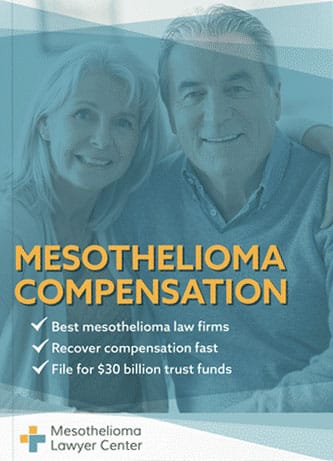Lung cancer and asbestos are sometimes connected if a person came into contact with asbestos for an extended period. Lung cancer has many causes, including prolonged asbestos exposure. Treatment involves chemotherapy, surgery, and radiotherapy, but the prognosis is not usually favorable.
If you’ve developed mesothelioma, asbestos-related lung cancer, or asbestosis, you may be entitled to significant compensation. We invite you to fill out our form today for a free Financial Compensation Packet, filled with information about experienced mesothelioma lawyers in your area, how to get paid in 90 days, how to file an asbestos trust fund claim, and much more.


FREE Financial Compensation Packet
- Info on law firms that will recover your HIGHEST COMPENSATION
- Learn how to get paid in 90 days
- File for your share of $30 billion in trust funds

About Asbestos and Lung Cancer
Lung cancer is one of the most commonly diagnosed types of cancer. Only a small percentage of these diagnoses are related to asbestos exposure. Smoking is the primary cause, but asbestos can also cause lung cancer.
Asbestos was used for many years in several industries, exposing thousands of workers. Workers who inhaled asbestos fibers year after year were at risk for lung cancer, mesothelioma, and other illnesses.
How Does Asbestos Cause Lung Cancer?
The primary cause of asbestos-related diseases is prolonged exposure to asbestos dust in materials that contain either chrysotile or amphibole asbestos fibers.
Asbestos usually enters the body when inhaled or swallowed. Inhalation is the most common method of infiltration because the fibers are small and are easily introduced into the air by human activity.
Most asbestos exposure cases occur during the mining and processing of raw minerals, the constant handling of asbestos-containing materials (ACMs), or when older buildings made before the early 1980s are renovated or torn down.
Sometimes, asbestos is transferred secondhand to family members via clothing and protective gear.
No matter how asbestos becomes lodged in the body, asbestos fibers can build up in the lungs, causing damage that may lead to cancer.
Over time, the asbestos fibers cause scarring and inflammation in the tissue where they lodge. Eventually, these inflammations may mutate into cancerous growths that can cause lung cancer.
According to the American Cancer Society (ACS), there is no “safe” asbestos. However, people exposed to asbestos for prolonged periods are at the highest risk for lung cancer.
How Long Does it Take to Develop Lung Cancer After Asbestos Exposure?
Asbestos lung cancer has a long latency period. The latency period is the time between asbestos exposure and the onset of symptoms that lead to a diagnosis.
The latency period must be at least ten years for lung cancer to be connected to asbestos exposure. It can be even longer, with several decades between exposure and illness.
How Much Asbestos Exposure Causes Lung Cancer?
There is no safe amount of asbestos exposure. A one-time exposure can cause harm but is unlikely to lead to lung cancer. People at the highest risk for asbestos lung cancer were exposed to asbestos repeatedly in their workplace for many years.
What Is the Most Common Cancer Associated With Asbestos?
Lung cancer is much more common than mesothelioma, but mesothelioma is more often associated with asbestos exposure. This is because there are other, more likely, causes of lung cancer, like smoking. The only known cause of mesothelioma is asbestos exposure.
What Is the Difference Between Asbestos Lung Cancer and Mesothelioma?
Mesothelioma is another type of cancer caused by asbestos exposure. It is very rare, accounting for about 3,000 diagnoses of cancer per year in the U.S. Lung cancer is much more common, with more than 200,000 new cases every year.
Mesothelioma is sometimes referred to as a type of lung cancer, but this is inaccurate. Lung cancer forms in the lung tissue. Mesothelioma forms in the mesothelium, a double layer of tissue that lines body cavities and organs.
The most common type of mesothelioma is pleural mesothelioma. It develops in the tissue around the lungs, which makes it easy to confuse with lung cancer. Pleural mesothelioma often spreads to the lungs, which further complicates diagnosis.
What Types of Lung Cancer Are Caused By Asbestos?
Two main types of lung cancer can both be caused by asbestos exposure:
- Non-Small Cell Lung Cancer. (NSCLC). NSCLC is the most common type of lung cancer with several subtypes. Adenocarcinoma develops in glandular cells and the alveoli of the lungs. It is most common in non-smokers. Squamous cell carcinoma develops in cells in the lining of the lungs. Large cell carcinoma forms in any part of the lungs and spreads more rapidly than other types.
- Small Cell Lung Cancer (SCLC). SCLC only accounts for 10% to 15% of lung cancer diagnoses. It is more difficult to treat than NSCLC and often spreads or metastasizes before showing any symptoms. Chemotherapy is the most common treatment for SCLC, as many patients are not candidates for surgery.
Who Is at Risk of Getting Lung Cancer From Asbestos Exposure?
Even though asbestos use in the U.S. has declined sharply over the past 40 years, its widespread use in many industries throughout much of the 20th Century places everyone at some level of risk of asbestos exposure.
In addition, homes, schools, public buildings, and other structures built before the early 1980s still contain large amounts of asbestos in insulation, vinyl flooring, roofing materials, and various types of pipes.
Also, since asbestos occurs naturally, people can be exposed to small amounts if they live near abandoned mines or rocky deposits that undergo wind and water erosion.
Per the National Cancer Institute (NCI), the risk factors for getting sick from asbestos exposure are:
- Dose (the amount of asbestos a person is exposed to regularly)
- Duration (the amount of time a person undergoes exposure to asbestos)
- Shape, size, and chemical composition of the asbestos fibers
- Exposure source (if it occurs in nature or if it is caused by human activity)
- Individual risk factors (pre-existing lung illnesses or smoking tobacco products)
People who smoke regularly also increase their chances of developing lung cancer.
How Do Doctors Prove Asbestos Caused Lung Cancer?
Workplace asbestos exposure is most often negligent. Victims who get sick later often sue for damages or make claims with asbestos trust funds for compensation.
Proving that asbestos contributed to lung cancer is vital for getting compensation. Doctors can show asbestos was involved in the development of lung cancer in a few ways:
- A previous diagnosis of an asbestos illness or signs of another asbestos illness, such as asbestosis
- The presence of pleural plaques, areas of thickened tissue caused by asbestos exposure
- The presence of asbestos fibers in lung tumors
- A period of ten years or longer between asbestos exposure and lung cancer
A history of smoking does not necessarily mean asbestos wasn’t a primary cause of lung cancer. It does not automatically disqualify a person from collecting compensation.
Smoking and Asbestos Lung Cancer
Asbestos exposure can cause lung cancer in non-smokers. Heavy smokers are more likely to develop cancers in the respiratory system, including the throat and lungs.
The combination of smoking and asbestos exposure is particularly dangerous. Studies show that the combination of smoking and asbestos is more harmful than the risks of either added together. This means they somehow work together to significantly increase the risk of developing cancer.
Studies also indicate that quitting smoking reduces the risk of developing lung cancer in people exposed to asbestos. There is no evidence that smoking increases the risk of developing mesothelioma in asbestos-exposed workers.
Signs and Symptoms of Asbestos Lung Cancer
Although there is some variation by individual, the symptoms of lung cancer are generally the same regardless of the cause:
- A cough that does not go away
- A cough that gets worse over time
- Coughing up blood
- Difficulty breathing
- Wheezing
- Chest pains that get worse with coughing, laughing, and deep breaths
- Unexplained weight loss
- Chronic tiredness
- Hoarseness
- Frequent lung infections
How Is Asbestos Lung Cancer Diagnosed?
After undergoing a physical exam and medical history, the next step in diagnosing lung cancer involves imaging scans. X-rays, CT scans, PET scans, and MRIs can give doctors a good view of lung tissue and any potentially cancerous tumors.
The next step is a biopsy. Typically, a needle biopsy is adequate to remove some tissue for study. Pathologists examine the tissue for cancer cells and identify the type of cancer. Another option for a lung biopsy is a bronchoscope, a tube that goes into the airways from the lungs.
With a diagnosis of lung cancer, doctors will then assign a stage. The stage depends on how far the cancer has spread regionally or to distant parts of the body.
Treatment for Asbestos Lung Cancer
Treating asbestos lung cancer is challenging. Medical intervention can relieve a patient’s symptoms, slow the development of lung cancer, and stave off complications.
Patients with small-cell lung cancer have several options for treatment. Currently, there are three major types of treatment:
- Surgery
- Chemotherapy
- Radiation therapy
These treatments can slow down the progress of cancer by surgically removing affected tissue or killing off cancer cells with radiation or chemicals.
Sometimes, a combination of two or more of these treatments can prevent, or at least delay, the onset of complications caused by cancer. They can also potentially extend a patient’s life expectancy by months, even years.
New treatments available to some patients include immunotherapy, targeted therapies, and gene therapy.
What Is the Prognosis for Asbestos Lung Cancer?
The prognosis for asbestos lung cancer is often poor. This is usually because of a late diagnosis later in the disease. Individual factors determine a different prognosis for every patient:
- The stage of the cancer
- Patient age and overall health
- Treatment choices
- Smoking status
The five-year survival rate is a useful prognosis statistic describing how many people live five years after their diagnosis. The five-year survival rates for the different stages of non-small cell lung cancer are:
- Localized – 65%
- Regional – 37%
- Distant – 9%
- Combined – 28%
The five-year survival rates for the different stages of small cell lung cancer are:
- Localized – 30%
- Regional – 18%
- Distant – 3%
- Combined – 7%
If you have a diagnosis of lung cancer and believe you were exposed to asbestos, talk to your doctor about it. Then, contact a mesothelioma lawyer to find out how to seek compensation.
Additional Help with Asbestos Lung Cancer
If you’ve been injured by mesothelioma, asbestos-related lung cancer, or asbestosis, keep in mind that there is a good chance that you’ll qualify for considerable compensation. Don’t forget to fill out our form to get our free Financial Compensation Packet, filled with information on the experienced asbestos and mesothelioma attorneys in your area.

Paul Danziger
Reviewer and EditorPaul Danziger grew up in Houston, Texas and earned a law degree from Northwestern University School of Law in Chicago. For over 25 years years he has focused on representing mesothelioma cancer victims and others hurt by asbestos exposure. Paul and his law firm have represented thousands of people diagnosed with mesothelioma, asbestosis, and lung cancer, recovering significant compensation for injured clients. Every client is extremely important to Paul and he will take every call from clients who want to speak with him. Paul and his law firm handle mesothelioma cases throughout the United States.
References
- National Cancer Institute. (2021, November 29). Asbestos Exposure and Cancer Risk.
Retrieved from: http://www.cancer.gov/cancertopics/factsheet/Risk/asbestos - American Cancer Society. (2019, October 1). If You Have Small Cell Lung Cancer.
Retrieved from: http://www.cancer.org/cancer/lungcancer-smallcell/detailedguide/small-cell-lung-cancer-diagnosis - National Cancer Institute. (2023, March 7). Common Cancer Types.
Retrieved from: https://www.cancer.gov/types/common-cancers
